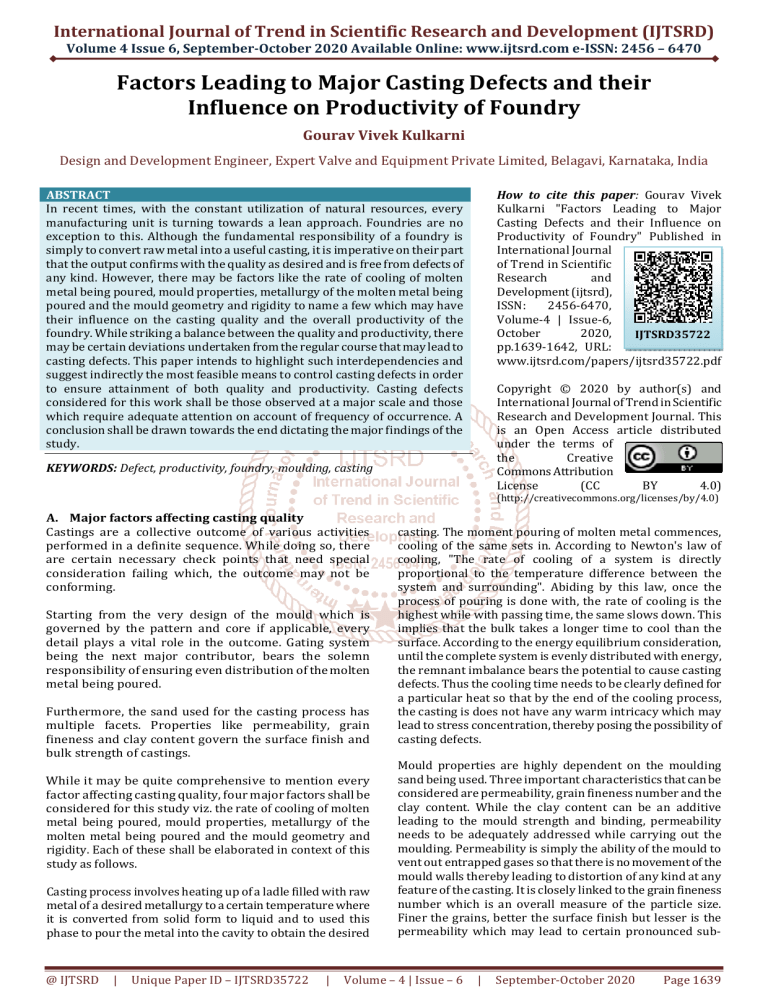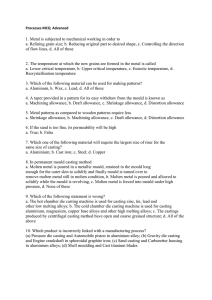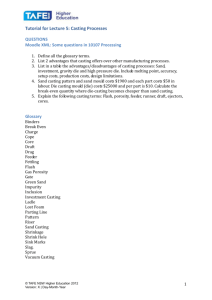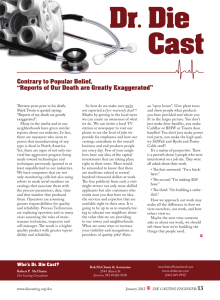
International Journal of Trend in Scientific Research and Development (IJTSRD)
Volume 4 Issue 6, September-October 2020 Available Online: www.ijtsrd.com e-ISSN: 2456 – 6470
Factors Leading to Major Casting Defects and their
Influence on Productivity of Foundry
Gourav Vivek Kulkarni
Design and Development Engineer, Expert Valve and Equipment Private Limited, Belagavi, Karnataka, India
ABSTRACT
In recent times, with the constant utilization of natural resources, every
manufacturing unit is turning towards a lean approach. Foundries are no
exception to this. Although the fundamental responsibility of a foundry is
simply to convert raw metal into a useful casting, it is imperative on their part
that the output confirms with the quality as desired and is free from defects of
any kind. However, there may be factors like the rate of cooling of molten
metal being poured, mould properties, metallurgy of the molten metal being
poured and the mould geometry and rigidity to name a few which may have
their influence on the casting quality and the overall productivity of the
foundry. While striking a balance between the quality and productivity, there
may be certain deviations undertaken from the regular course that may lead to
casting defects. This paper intends to highlight such interdependencies and
suggest indirectly the most feasible means to control casting defects in order
to ensure attainment of both quality and productivity. Casting defects
considered for this work shall be those observed at a major scale and those
which require adequate attention on account of frequency of occurrence. A
conclusion shall be drawn towards the end dictating the major findings of the
study.
How to cite this paper: Gourav Vivek
Kulkarni "Factors Leading to Major
Casting Defects and their Influence on
Productivity of Foundry" Published in
International Journal
of Trend in Scientific
Research
and
Development (ijtsrd),
ISSN:
2456-6470,
Volume-4 | Issue-6,
October
2020,
IJTSRD35722
pp.1639-1642, URL:
www.ijtsrd.com/papers/ijtsrd35722.pdf
Copyright © 2020 by author(s) and
International Journal of Trend in Scientific
Research and Development Journal. This
is an Open Access article distributed
under the terms of
the
Creative
Commons Attribution
License
(CC
BY
4.0)
KEYWORDS: Defect, productivity, foundry, moulding, casting
(http://creativecommons.org/licenses/by/4.0)
A. Major factors affecting casting quality
Castings are a collective outcome of various activities
performed in a definite sequence. While doing so, there
are certain necessary check points that need special
consideration failing which, the outcome may not be
conforming.
Starting from the very design of the mould which is
governed by the pattern and core if applicable, every
detail plays a vital role in the outcome. Gating system
being the next major contributor, bears the solemn
responsibility of ensuring even distribution of the molten
metal being poured.
Furthermore, the sand used for the casting process has
multiple facets. Properties like permeability, grain
fineness and clay content govern the surface finish and
bulk strength of castings.
While it may be quite comprehensive to mention every
factor affecting casting quality, four major factors shall be
considered for this study viz. the rate of cooling of molten
metal being poured, mould properties, metallurgy of the
molten metal being poured and the mould geometry and
rigidity. Each of these shall be elaborated in context of this
study as follows.
Casting process involves heating up of a ladle filled with raw
metal of a desired metallurgy to a certain temperature where
it is converted from solid form to liquid and to used this
phase to pour the metal into the cavity to obtain the desired
@ IJTSRD
|
Unique Paper ID – IJTSRD35722
|
casting. The moment pouring of molten metal commences,
cooling of the same sets in. According to Newton's law of
cooling, "The rate of cooling of a system is directly
proportional to the temperature difference between the
system and surrounding". Abiding by this law, once the
process of pouring is done with, the rate of cooling is the
highest while with passing time, the same slows down. This
implies that the bulk takes a longer time to cool than the
surface. According to the energy equilibrium consideration,
until the complete system is evenly distributed with energy,
the remnant imbalance bears the potential to cause casting
defects. Thus the cooling time needs to be clearly defined for
a particular heat so that by the end of the cooling process,
the casting is does not have any warm intricacy which may
lead to stress concentration, thereby posing the possibility of
casting defects.
Mould properties are highly dependent on the moulding
sand being used. Three important characteristics that can be
considered are permeability, grain fineness number and the
clay content. While the clay content can be an additive
leading to the mould strength and binding, permeability
needs to be adequately addressed while carrying out the
moulding. Permeability is simply the ability of the mould to
vent out entrapped gases so that there is no movement of the
mould walls thereby leading to distortion of any kind at any
feature of the casting. It is closely linked to the grain fineness
number which is an overall measure of the particle size.
Finer the grains, better the surface finish but lesser is the
permeability which may lead to certain pronounced sub-
Volume – 4 | Issue – 6
|
September-October 2020
Page 1639
International Journal of Trend in Scientific Research and Development (IJTSRD) @ www.ijtsrd.com eISSN: 2456-6470
surface defects. This makes it imperative to provide
additional venting in the box as found appropriate.
Metallurgy of the molten metal being poured is necessary to
be comprehended to the best possible extent while designing
the gating system and the cavity. Depending on the alloying
elements, properties of molten metal like viscosity, density
and fluidity vary. Desired results are largely a function of a
pre-determined metallurgy backed with appropriate design
of the cavity including the gating system.
Mould geometry refers to the design of mould box wherein
the cavity is created. The wall thickness of mould is
necessary to be adequate in order to avoid defects related to
the packing. Rigidity of a mould is the ability of its
components viz. cope, drag and cheek if applicable to remain
intact during the pouring and cooling process.
These are a few factors that bear a major share in influencing
the quality of castings, be it of any metal.
B. Major casting defects observed for grey cast iron,
carbon steel and stainless steel castings
This study shall be largely limited to Grey cast iron,
Carbon steel and stainless steel castings. When these
castings are encountered, there are certain commonly
observed defects that are likely to occur.
As a premier thought, it is necessary to ponder over the
idea that what causes the casting defects. It is a well
established fact that if the process is followed, the end
result is always as desired. As a corollary, one may state
that if the process is not followed as defined, the
occurrence of castings defects would be quite inevitable
and their frequency would be high if not taken care of.
As a part of observations it was found that there are six
casting defects that are quite prominent are need
academic attention in all regards. These have been
considered for this study while other numerous defects
shall be out of purview of the same. The casting defects
taken up for study include blow holes, pin holes,
shrinkage, surface roughness, shift and sand inclusions.
Subsequent sections shall elaborate these defects and
shall set a premise to this study. Casting defects are
certainly undesirable but at the same time, it is evident
that they are not completely avoidable too. Hence it is
required that efforts are taken up to reduce the same to
the best possible extent.
C. Elaborate comprehension of casting defects and
interdependence of factors causing the same
In this section, each casting defect under investigation
shall be firstly understood. Thereafter interdependence of
the factors affecting the same shall be presented to link
the factors with the casting defects.
C.A. Blow holes
Blow holes are caused due to entrapped gases forming
bubbles within the bulk of the casting. Until discovered by
machining process, these defects may remain unnoticed
and may lead to severe failures due to stress
concentration. Blow holes are generally spherical in shape
are few in number. Their peculiar characteristic involves
a surface luster which can be attributed to the presence of
the entrapped gases.
@ IJTSRD
|
Unique Paper ID – IJTSRD35722
|
Gases can bet entrapped in the bulk of the casting due to a
number of reasons like sand permeability, gating system,
design of intricacies, casting wall thickness and
metallurgy to name a few.
Permeability of the sand is a function of the grain fineness
number. For sand with large number of fine particles,
there is a greater degree of packing of the sand grains in
the mould. This leads to possibility of entrapped gases if
the venting system is incapable of letting the entrapped
gases as exhaust.
Design intricacies may be the product requirement but
gating system can be kept a check and measure to ensure
that the thinnest of the cavity is completely filled with the
molten metal.
Casting wall thickness is the cavity between the mould
wall and the core. Depending on the metal being poured,
there is a certain minimum value that needs to be
maintained in case of sand castings. Failure to adhere to
this condition can invite untoward occurrence of blow
holes.
C.B. Pin holes
Pin holes are frequently observed in stainless steel
castings. This a sub surface defect that can again be
attributed to incomplete deoxidation of the molten metal
in the mould.
Pin holes generally occur at locations where the molten
metal cools in an uneven manner leaving certain hot spots
to pave way to occurrence of the defect.
C.C. Shrinkage
Shrinkage mainly refers to the occurrence of undersize
dimensions on the casting as that compared to the desired
dimensions. During the process of cooling of the metal
poured into the cavity, due to the property of solids of
contraction on cooling, metals too tend to contract and
shrink with the onset of cooling. Taking this into account,
shrinkage allowances provided may work best in the
presence of a properly designed gating system.
There are two standpoints when it comes to shrinkage
defect. One being lack of consideration of the shrinkage
and the mould wall movement allowance and the other
being improper design of the gating system.
Owing to the properties of the metal being poured and the
shape to be cast, there are various allowances that are
provided on the pattern to accommodate certain changes
that take place in the casting while cooling is onset.
Shrinkage allowance for gray cast iron is lesser than that for
carbon steel which is slightly lesser than that for stainless
steel. Thus to cast a part of given dimension, the cavity for
grey cast iron may be of the least volume while that of the
stainless steel shall be most. In event the same is swapped,
there can be shrinkage defects that can be observed. Using a
grey cast iron cavity for steel can result into castings with
undersize dimensions while using of steel cavity for grey cast
iron leads to lesser shrinkage and greater material to be
machined. Either ways, the loss is on the manufacturer.
Mould wall movement allowance is provided considering the
minor movement of the mould wall due to pressure when
Volume – 4 | Issue – 6
|
September-October 2020
Page 1640
International Journal of Trend in Scientific Research and Development (IJTSRD) @ www.ijtsrd.com eISSN: 2456-6470
the molten metal is poured. Loosely packed facing and
backing sand may lead to an oversized casting in this case.
factors have their own role in the productivity and the
economics of moulding and casting process.
C.D. Surface roughness
This is a surface defect and is clearly visible to the
observer. The prominent causes include employment of
too coarse grain sand leading to an uneven surface and a
relatively high pouring temperature.
The rate of cooling of molten metal being poured is
characteristic to the given metal. It is also dependent on
the shape and volume of the cavity. Intricacies also
contribute a major part in the determination of the overall
cooling time. If all these factors are considered, the
cooling time required for a casting would be in terms of
hours which may not be economically feasible for a
foundry owing to space constraints and mould box
requirements. Thus it may be observed that after a short
cooling duration of an hour or two moulding boxes may
be withdrawn and used for moulding of further cavities.
At this stage, although the metal is externally cooled,
there are intricacies where the metal is not completely
cooled and this may lead to distortions in castings.
Although space is a major constraint, specific cooling
areas can be designated with vertical arrangement
wherein the heaviest moulds are placed at the bottom and
relatively lighter ones are placed at the subsequent top
levels.
This is the reason, the grain fineness number of the sand
used has to be pre-determined so that necessary actions
can be administered.
Pouring temperature is defined as a relative term because
depending on the size of the cavity, the molten metal may
tend to vapourize a relative quantity of facing sand and
create room for surface roughness. The secondary effects
of surface roughness include occurrence of sub-surface
porosity.
C.E. Shift
Casting manufactured using multiple peace patterns are
prone to this defect. depending on the space and
moulding box availability at the foundry, a pattern may be
split in two or more pieces. Generally, when the pattern
and core box are newly manufactured, the locators are
easily placed and the cavity can be produced accordingly.
However with time, wear of pattern reference surfaces
can cause shifts in the cavity. This may be one reason for
shifts, the other being movement of mould boxes during
and after pouring. If not held in place, the mould boxes
holding the molten metal have the tendency to move
apart to establish the equilibrium to cool the metal within
much more evenly. If adequate constrains are not in place,
shifts in castings may occur which would be highly
undesirable. Another reason for occurrence could be a
misaligned core which may lead to internal movement
and distortions if the moulding sand at the core print is
not compacted adequately.
C.F. Sand Inclusions
In this defect, one can observe sand grains entrapped in
minor pockets of the castings. Sand and mould cavity
preparation are further causes of this defect wherein a
small lump of sand may get detached from the surface of
the cavity and can appear as a sand inclusion.
Metallurgy of the molten metal being poured may also be
responsible in the event of presence of oxides and
reaction products of metals being cast.
Gating system is another cause wherein Too narrow
runners and gates can lead the flowing molten metal to
initiate the casting defect.
D. Influence of defect causing factors on productivity
of foundry
Having comprehend the influence of various parameters
on the defects caused, the study shall now be extended to
influence of defect causing factors on the productivity of
the foundry.
Productivity of a foundry may be defined as efficient
conversion of raw metal into castings with minimum
casting defects and rejections thereby. Defect causing
@ IJTSRD
|
Unique Paper ID – IJTSRD35722
|
Mould properties include the level of compactness of the
sand, quality of sand used, box size and so on. Unlike
earlier, currently there are moulding machines that can
ease the job of manual labour. However, if one tries to
compact the sand in a particular mould box, there would
be a pile up of boxes at the station leading to a bottleneck.
Additional moulding machine may although be an option
but the overall flow line may be greatly affected. Thus to
strike a balance, it is a practice to ram the sand for a
certain standard duration. This is most of the times
sufficient but in rare cases, may lead to defects. Sand
reclamation is necessary to save on unnecessary costs at a
foundry. However, after a certain number of cycles, it is
necessary that the sand is prepared afresh to ensure
better quality of castings.
Metallurgy is an area wherein minor variation of the
constituents can lead to major changes in the end product.
Addition of carbon is an example to the point. It can
largely affect the metallurgy of the casting if not
controlled.
Mould geometry and rigidity is another important
consideration in this wise. The physical condition of the
mould box including the walls and the dowel pins used to
secure the boxes with reference to the match plate plays a
vital role in the production of sound castings. Due to
excessive and repetitive use, there may be wear and tear
of the dowel pins which can lead to loosely fit moulds and
can lead to defects like shifts. These aspects may not be
addressed in detail due to their petit magnitude but it is
necessary to have cognizance of their effects so that major
defects can be avoided.
Conclusion
Thus it can be concluded that various factors leading to major
casting defects have been comprehended and from the study
of their influence on productivity, it has been found that there
are certain practices that call for deviation from the set
processes which are undertaken to save on certain
parameters like time and money, but are potentially
deterrent to the overall productivity. It is recommended that
Volume – 4 | Issue – 6
|
September-October 2020
Page 1641
International Journal of Trend in Scientific Research and Development (IJTSRD) @ www.ijtsrd.com eISSN: 2456-6470
the cooling time required by the casting is provided in total
without consideration of engagement of mould box, moulding
and associated processes are carried out appropriately and
the metallurgy is taken care of during the manufacturing
activities.
Acknowledgement
The author sincerely thanks Management of Expert Valve and
Equipment Private Limited, Belagavi, Karnataka for their
continuous support and Mr. Rakesh Dhanaji Bucche and
@ IJTSRD
|
Unique Paper ID – IJTSRD35722
|
Xavier Paul Pinto, Quality Control Department for their inputs
to come up with this work.
References
[1] R. K. Jain, "Production Technology", Khanna
Publishers, Seventeenth edition, 2013, ISBN No. 817409-099-1
[2]
Rajinder Singh, "Introduction to basic Manufacturing
Processes and Workshop Technology", New Age
International Publishers, 2006, ISBN No. 81-2242316-7
Volume – 4 | Issue – 6
|
September-October 2020
Page 1642








